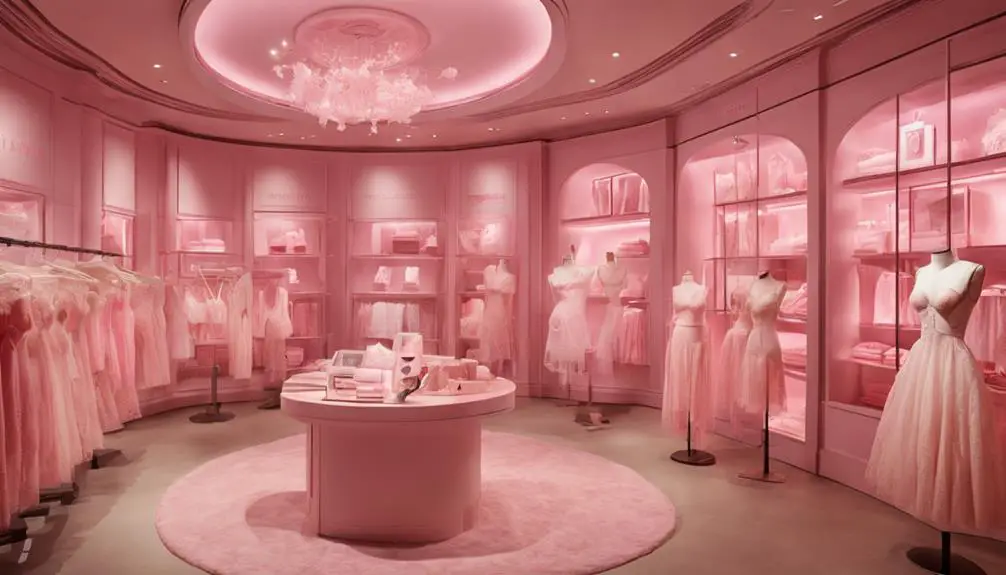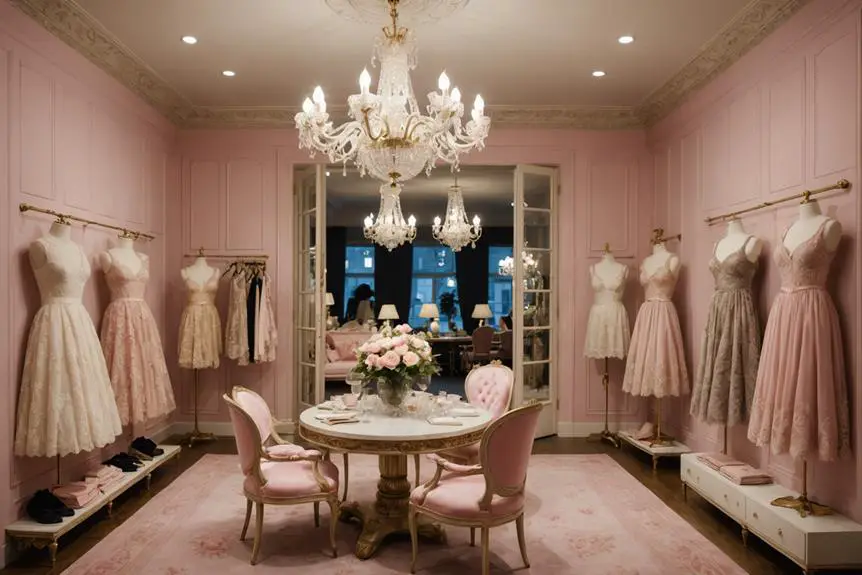Victoria's Secret was founded on June 12, 1977, by Roy Raymond in San Francisco. He aimed to create a more inviting lingerie shopping experience for both men and women, inspired by the elegance of the Victorian era. With an initial $80,000 in loans, his first boutique generated an impressive $500,000 in sales that first year. By 1982, the brand expanded to six stores but struggled financially, leading to its sale to Leslie Wexner. Under Wexner's direction, Victoria's Secret transformed into a female-focused brand, ultimately becoming the largest lingerie retailer in the U.S. Discover how this journey shaped modern lingerie!
Founding Vision of Roy Raymond
Roy Raymond's founding vision for Victoria's Secret was rooted in his desire to transform the lingerie shopping experience. He recognized that shopping for lingerie could be uncomfortable, especially for men looking to buy gifts for their partners. This discomfort inspired him to create a boutique that offered a more inviting and comfortable shopping environment. On June 12, 1977, in San Francisco, he opened the first store, aiming to change how people viewed lingerie.
Raymond wanted Victoria's Secret to feel different from traditional department stores. Drawing inspiration from the Victorian era, he chose a name that evoked elegance and propriety. He believed that lingerie shopping should be an enjoyable experience, not one filled with awkwardness. To bring his vision to life, he secured a $40,000 bank loan and borrowed another $40,000 from his in-laws, allowing him to launch his dream in a suburban shopping center.
In its first year, Victoria's Secret generated impressive sales of around $500,000. This success fueled Raymond's ambition for expansion, leading to the opening of six additional stores by 1982.
His innovative approach not only changed the perception of lingerie but also laid the groundwork for a brand that would become a household name. By prioritizing comfortable shopping and creating an elegant atmosphere, Roy Raymond truly revolutionized how people interacted with lingerie, setting Victoria's Secret on a path to incredible growth and success.
First Store and Early Success
The launch of Victoria's Secret marked a pivotal moment in the lingerie retail landscape. Founded by Roy and Gaye Raymond on June 12, 1977, the first store opened in the Stanford Shopping Center in Palo Alto, California. Roy's uncomfortable experience shopping for lingerie inspired him to create an environment that made men feel at ease while buying for their partners.
This innovative approach led to early success, as the store generated an impressive $500,000 in sales during its first year. Victoria's Secret focused on creating a comfortable shopping experience, which was a game-changer in the industry. By 1982, the brand had expanded to six stores and reported annual sales of around $6 million.
The concept of a lingerie store that appealed to male buyers, while also considering female customers, set Victoria's Secret apart from traditional retailers. However, despite this early success, the company faced financial difficulties. In 1982, Roy Raymond made the difficult decision to sell Victoria's Secret to Leslie Wexner for $1 million.
This sale would ultimately pave the way for a transformation that would reshape the brand's future. Wexner saw the potential that others may have overlooked, and his vision would lead to further expansion and the iconic status Victoria's Secret would later achieve.
In just a few short years, Victoria's Secret went from a single store to a recognized name in lingerie, changing how people shop for intimate apparel forever.
Transition of Ownership in 1982
In 1982, the ownership of Victoria's Secret shifted markedly when Leslie Wexner stepped in to buy the company from Roy Raymond for $1 million. At this point, Victoria's Secret was facing serious financial difficulties, with annual sales hovering around $4 million. Wexner recognized the potential in the brand and began a major transformation that would change its future.
Under Wexner's leadership, the focus moved away from the male-driven sales approach that Roy Raymond had initially adopted. Instead, Wexner implemented a female-oriented marketing strategy that appealed directly to women. He wanted to position lingerie not just as an intimate necessity, but as an affordable luxury inspired by chic European boutiques. This shift made lingerie feel more accessible and desirable for everyday women.
Wexner's vision didn't stop there; he spearheaded the expansion of Victoria's Secret, growing the number of stores considerably. By 1995, just over a decade after the acquisition, Victoria's Secret had blossomed into a retail powerhouse, boasting 670 stores across the U.S. and reaching a staggering valuation of $1.9 billion.
Leslie Wexner's acquisition of Victoria's Secret marked a turning point that set the stage for the brand's rise in popularity. His commitment to a fresh, female-friendly approach not only saved the company but also helped redefine the lingerie market, making it a staple in the lives of countless women across the nation.
Rise to Market Dominance
With Leslie Wexner's innovative approach, Victoria's Secret quickly climbed to the top of the lingerie market. By the early 1990s, it became the largest lingerie retailer in the U.S., boasting 350 stores and sales exceeding $1 billion. Wexner's keen marketing strategies played an essential role in this impressive growth.
One standout initiative was the launch of the annual Victoria's Secret Fashion Show in 1995, which transformed into a cultural phenomenon, drawing millions of viewers and enhancing brand visibility.
Key product introductions greatly contributed to Victoria's Secret's success. The Miracle Bra, launched in 1993, revolutionized women's intimate apparel, skyrocketing sales and solidifying the brand's market position. Following this, the Body by Victoria line in 1999 further captivated customers, showcasing the brand's commitment to comfort and style.
Victoria's Secret also crafted a distinct brand identity through its marketing, featuring high-profile models known as "Angels." These glamorous figures not only enhanced the brand's allure but also created a sense of aspiration for customers.
Evolution of Brand Identity

Victoria's Secret has undergone a remarkable evolution in brand identity since its inception in 1977. Founded by Roy Raymond, the brand initially aimed to provide a comfortable shopping experience for men buying lingerie for women. Inspired by his own discomfort in department stores, Raymond named the brand after the Victorian era, evoking elegance and sophistication. This helped establish its initial identity as a refined lingerie retailer.
In 1982, Leslie Wexner acquired Victoria's Secret for $1 million and shifted the focus from male shoppers to women. This change transformed the brand into a stylish and affordable luxury lingerie brand. Wexner implemented innovative marketing strategies, including the launch of the iconic Victoria's Secret Fashion Show in 1995. This event emphasized glamour and allure, further evolving the brand identity into one that celebrated confidence and femininity.
By the late 1990s, Victoria's Secret had carved out a significant niche in the market with its "Body by Victoria" line. This collection became synonymous with the brand's sexy aesthetic, solidifying its status as a market leader in lingerie. The combination of attractive products and savvy marketing turned Victoria's Secret into a household name.
Today, the brand continues to adapt, reflecting changing beauty standards and customer preferences. While its identity has evolved, Victoria's Secret remains committed to empowering women, ensuring that it stays relevant in an ever-changing industry.




